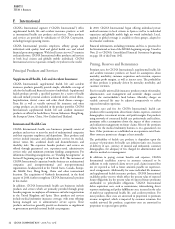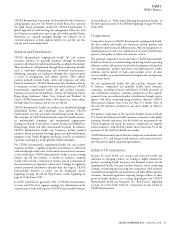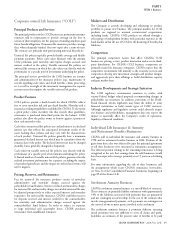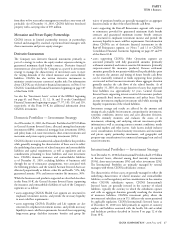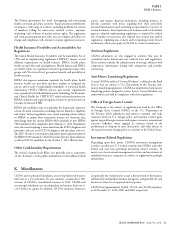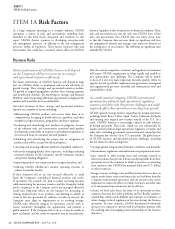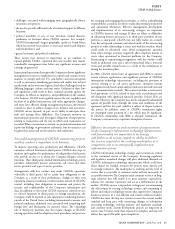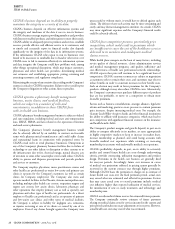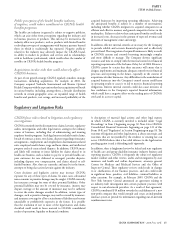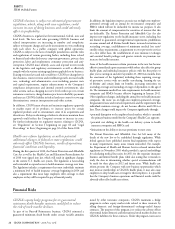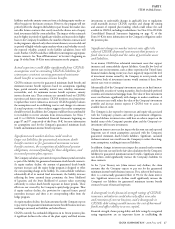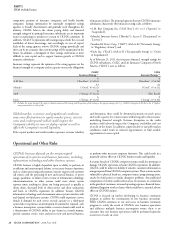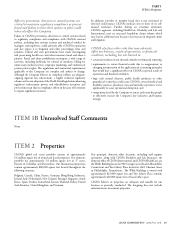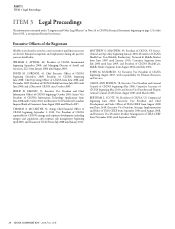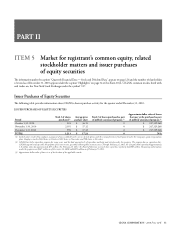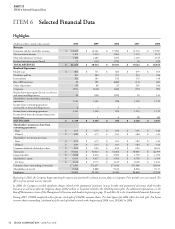Cigna 2010 Annual Report Download - page 42
Download and view the complete annual report
Please find page 42 of the 2010 Cigna annual report below. You can navigate through the pages in the report by either clicking on the pages listed below, or by using the keyword search tool below to find specific information within the annual report.
CIGNA CORPORATION 2010 Form 10K
22
PARTI
ITEM 1A Risk Factors
ITEM 1A Risk Factors
As a large company operating in a complex industry, CIGNA
encounters a variety of risks and uncertainties including those
identifi ed in this Risk Factor discussion and elsewhere in this
report. CIGNA devotes resources to developing enterprise-wide
risk management processes, in addition to the risk management
processes within its businesses. ese factors represent risks and
uncertainties that could have a material adverse eff ect on CIGNA’s
business, liquidity, results of operations or fi nancial condition. ese
risks and uncertainties are not the only ones CIGNA faces. Other
risks and uncertainties that CIGNA does not know about now,
or that the Company does not now think are signifi cant and does
not appropriately identify and manage, may impair its business or
the trading price of its securities. e following are signifi cant risks
identifi ed by CIGNA.
Business Risks
Future performance of CIGNA’s business will depend
on the Company’s ability to execute on its strategic
and operational initiatives eff ectively.
e future performance of CIGNA’s business will depend in large
part on CIGNA’s ability to implement and execute eff ectively its
growth strategy. ese strategic and operational initiatives include:
(1) growth in targeted geographies, product lines, buying segments
and distribution channels; (2) improving its strategic and fi nancial
fl exibility; and (3) pursuing additional opportunities in high-growth
markets with particular focus on individuals.
Successful execution of these strategic and operational initiatives
depends on a number of factors including:
•diff erentiating CIGNA’s products and services from those of its
competitors by leveraging its health advocacy capabilities and other
strengths in targeted markets, geographies and buyer segments;
•developing and introducing new products or programs, because
of the inherent risks and uncertainties associated with product
development, particularly in response to government regulation or
the increased focus on consumer directed products;
•identifying and introducing the proper mix or integration of
products that will be accepted by the marketplace;
•attracting and retaining suffi cient numbers of qualifi ed employees;
•eff ectively managing balance sheet exposures, including evaluating
potential solutions for the Company’s run-off reinsurance business
and pension funding obligation;
•improving medical cost competitiveness in targeted markets; and
•reducing CIGNA HealthCare’s medical operating expenses to
achieve sustainable benefi ts.
If these initiatives fail or are not executed eff ectively, it could
harm the Company’s consolidated fi nancial position and results
of operations. For example, the plan to reduce operating expenses
while maintaining the necessary resources and the Company’s talent
pool is important to the Company and if not managed eff ectively
could have long-term eff ects on the business by decreasing or
slowing improvements in its products and limiting its ability to
retain or hire key personnel. In addition, in order to succeed, the
Company must align its organization to its evolving strategy.
CIGNA must eff ectively integrate its operations, actively work to
ensure consistency throughout the organization, and promote a
global mind-set. If the Company fails to do so, it may be unable to
grow as planned, and the result of expansion may be unsatisfactory.
Also, the current competitive, economic and regulatory environment
will require CIGNA’s organization to adapt rapidly and nimbly to
new opportunities and challenges. e Company will be unable
to do so if it does not make important decisions quickly, defi ne its
appetite for risk specifi cally, implement new governance, managerial
and organizational processes smoothly and communicate roles and
responsibilities clearly.
As a multi-national company, CIGNA’s international
operations face political, legal, operational, regulatory,
economic and other risks that present challenges and could
negatively aff ect those operations or our long-term growth.
CIGNA’s growth strategy involves expanding our foreign operations
including South Korea, China, Spain, Turkey, Indonesia and India
and entering into targeted new markets outside of the U.S. As a
result, CIGNA’s business is increasingly exposed to risks inherent
in foreign operations. ese risks, which can vary substantially by
market, include political, legal, operational, regulatory, economic and
other risks, including government intervention and censorship that
the Company does not face in its U.S. operations. e global nature
of CIGNA’s business and operations presents challenges, including
but not limited to those arising from:
•varying regional and geopolitical business conditions and demands;
•discriminatory regulation, nationalization or expropriation of assets;
•price controls or other pricing issues and exchange controls or
other restrictions that prevent it from transferring funds from these
operations out of the countries in which it operates or converting
local currencies that CIGNA International holds into U.S. dollars
or other currencies;
•foreign currency exchange rates and fl uctuations that may have an
impact on the future costs or on future sales and cash fl ows from the
Company’s international operations, and any measures that it may
implement to reduce the eff ect of volatile currencies and other risks
of its international operations may not be eff ective;
•reliance on local sales forces for some of its operations in these
countries that may have labor problems and less fl exible employee
relationships which can be diffi cult and expensive to terminate, or
where changes in local regulation or law may disrupt the business
operations. In some countries, CIGNA International voluntarily
operates or is required to operate with local business partners with
the resulting risk of managing partner relationships to the business
objectives;


